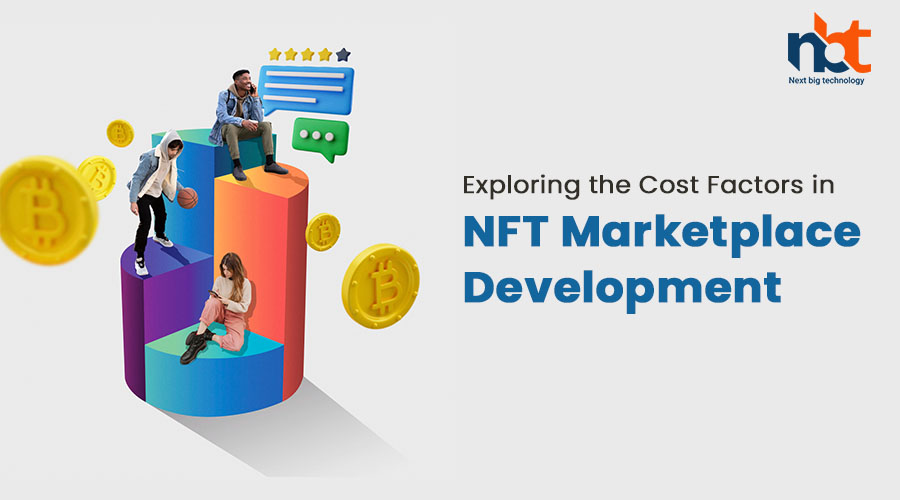Introduction: Non-Fungible Tokens (NFTs) have gained immense popularity in the digital world, revolutionizing the way we buy, sell, and own digital assets. NFT marketplaces serve as platforms for creators and collectors to trade these unique digital assets securely. If you’re considering building your own NFT marketplace, understanding the cost factors involved is crucial. In this blog, we will explore the various factors that influence the cost of NFT marketplace development, helping you estimate and plan your project effectively.
- Project Scope and Complexity: The scope and complexity of your NFT marketplace project will play a significant role in determining the development cost. Consider the features and functionalities you want to include in your marketplace, such as user registration, asset listing and browsing, bidding and purchasing mechanisms, secure payments, user profiles, search and filtering options, wallet integration, and smart contract implementation. The more complex and extensive your desired features, the higher the development cost will be.
- Blockchain Infrastructure: NFTs are typically built on blockchain platforms like Ethereum or Binance Smart Chain, which provide the necessary infrastructure for the creation, ownership, and transfer of these digital assets. The choice of blockchain platform can impact the development cost. Ethereum, being the most popular platform for NFTs, often comes with higher transaction fees and development costs. Alternatively, choosing a more cost-effective blockchain platform may require additional customization and development effort.
- Smart Contract Development: Smart contracts are the backbone of NFT marketplaces as they define the ownership, transfer, and verification of digital assets. Developing robust and secure smart contracts requires expertise in blockchain development. The cost of smart contract development will depend on factors such as the complexity of the contract, the level of customization required, and the expertise of the developers. Auditing and testing the smart contracts for security and functionality will also contribute to the overall development cost.
- User Interface and Design: A visually appealing and user-friendly interface is crucial for the success of an NFT marketplace. The design and user experience (UX) play a significant role in attracting users and encouraging engagement. Investing in professional UI/UX design services can enhance the overall user experience but may increase the development cost. The number of screens, customization requirements, and responsiveness across different devices should be considered in estimating the design-related costs.
- Backend Development: The backend of an NFT marketplace handles various operations, including user management, asset management, transaction processing, and integration with the blockchain. The complexity of the backend development will depend on factors like the number of users, concurrent transactions, scalability requirements, and integrations with external APIs or payment gateways. Building a secure and scalable backend that can handle the anticipated user load will add to the overall development cost.
- Integration with Payment Gateways and Wallets: NFT marketplaces require seamless integration with payment gateways to facilitate secure transactions. Integrating with popular payment providers such as Stripe or PayPal incurs additional costs, including setup fees, transaction fees, and ongoing maintenance costs. Similarly, integrating with cryptocurrency wallets to enable users to store, transfer, and manage their digital assets will require development effort and may involve third-party wallet providers that charge fees.
- Security and Auditing: Security is of utmost importance in NFT marketplaces, as they involve the transfer of valuable digital assets. Implementing robust security measures, such as encryption, secure user authentication, and transaction verification, is crucial. Regular security audits and penetration testing help identify and address vulnerabilities. Consider the cost of conducting security audits, obtaining necessary certifications, and ensuring compliance with industry regulations like Know Your Customer (KYC) and Anti-Money Laundering (AML) requirements.
- Testing and Quality Assurance: Thorough testing and quality assurance processes are essential to ensure a bug-free and reliable NFT marketplace. This includes functional testing, security testing, performance testing, and user acceptance testing. Investing in comprehensive testing helps identify and resolve issues before the marketplace goes live. Consider the cost of test environments, testing tools, and dedicated quality assurance resources to ensure a smooth user experience and minimize post-launch issues.
- Ongoing Maintenance and Updates: Once your NFT marketplace is launched, ongoing maintenance is necessary to ensure its smooth operation, fix any bugs or vulnerabilities, and introduce new features or enhancements. Consider the cost of maintenance and support, including server costs, cloud infrastructure, monitoring tools, and addressing user feedback and feature requests. Regular updates to keep up with blockchain advancements, security patches, and regulatory changes will also incur costs.
- Legal and Compliance: Navigating legal and compliance requirements is crucial for an NFT marketplace. This may include consulting with legal experts to ensure compliance with intellectual property rights, data privacy regulations, and user terms and conditions. Legal consultations and necessary documentation, such as terms of service and privacy policies, contribute to the overall cost.
Conclusion: Building an NFT marketplace involves several cost factors that need careful consideration. The project scope and complexity, blockchain infrastructure, smart contract development, user interface and design, backend development, payment gateway and wallet integration, security and auditing, testing and quality assurance, ongoing maintenance and updates, and legal and compliance requirements all contribute to the overall development cost. By analyzing these factors, you can effectively estimate and plan the budget for your NFT marketplace development project. Collaborating with experienced blockchain developers, UI/UX designers, and legal professionals can help optimize costs while ensuring a secure, user-friendly, and successful NFT marketplace.

















